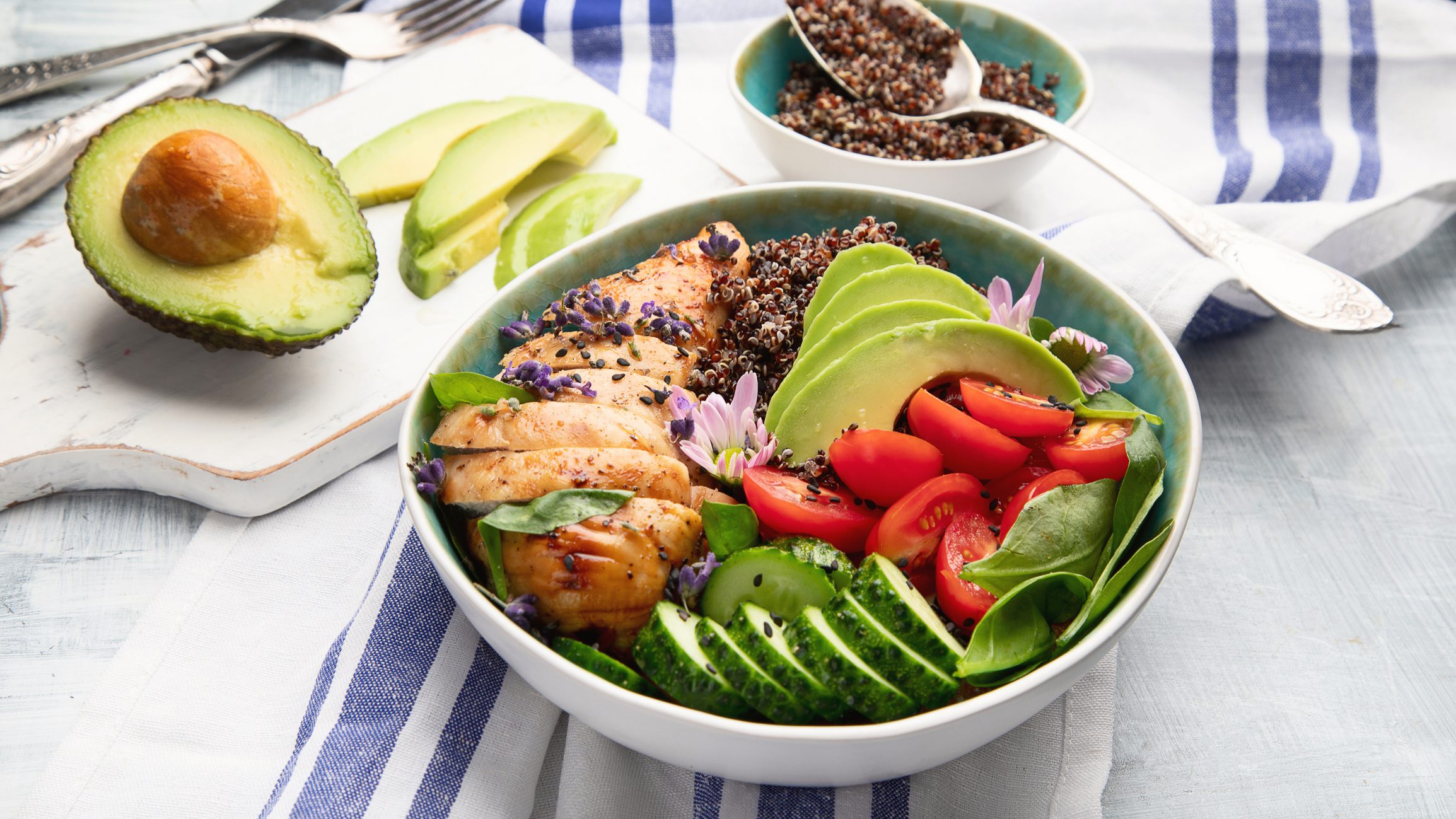Protein plays a pivotal role in promoting health and well-being, thanks to its numerous benefits. It is instrumental in supporting muscle growth, repair, and maintenance, and also aids in digestion, energy production, and nutrient breakdown.
Protein is also needed for hormone synthesis, including insulin and growth hormone, which play vital roles in regulating blood sugar and promoting growth. The immune system heavily relies on protein for producing immune cells and antibodies necessary to fend off infections and diseases. Collagen, a type of protein, provides structural support to various tissues including skin, bones, tendons, and ligaments.
More practically, eating protein-rich foods can keep you full longer. This macronutrient promotes satiety, reduces hunger, and curbs cravings, and compared with carbs or fat, protein has a higher thermic effect.1 In other words, protein requires more energy to digest and metabolize.
If you’re on a fat-loss journey, a protein-first approach to your diet helps preserve muscle mass and ensures the weight you lose comes predominantly from fat. This is crucial as maintaining or even increasing muscle mass boosts the resting metabolic rate, leading to more calories burned at rest. A higher protein intake may even increase the rate at which your body burns fat.
You’ll want to choose foods with the biggest protein bang for your buck to get these benefits. With that in mind, I’ve provided 12 of my top-shelf protein-rich foods. You’ll quickly see these nutrient superstars offer far more than just protein. Vitamins, minerals, antioxidants, and other nutrients complement protein’s benefits for muscle growth and repair, appetite management, blood-sugar balance, and more.

12 High-Protein Foods
I’ve provided animal- and plant-protein sources. Animal proteins have all nine essential amino acids, making them complete proteins. They consistently deliver a superior protein profile.
Plant proteins, on the other hand, are sometimes (but not always) low in one or more essential amino acids, making them incomplete proteins. Consuming foods with incomplete proteins can make it more challenging to meet your protein quota because your body requires all nine essential amino acids to build and repair tissues, support growth, and carry out various biochemical functions.
Every serving of Amino Power Powder provides all nine essential amino acids, the conditionally essential amino acid L-arginine, alpha-ketoglutarate, and vitamin B6 for optimal absorption and availability. The delicious fruit punch flavor, sweetened with stevia with zero sugar, mixes easily into your favorite liquid.
1. Wild-Caught Salmon
Wild-caught fish is rich in high-quality, complete protein, providing all the essential amino acids your body needs for muscle growth, repair, and more. A 5.5-oz serving of cooked wild salmon provides about 30 grams of protein.
Overall, wild-caught fish tend to have lower contaminants like mercury than some farmed fish. Choose wild-caught fish from sustainable sources to support responsible fishing practices and protect marine ecosystems. Vital Choice is my go-to source for the highest-quality seafood, including wild-caught salmon and canned seafood.
What Other Nutrients Does It Offer?
- Essential fatty acids. Fatty fish like salmon also provide the anti-inflammatory omega-3 fatty acids eicosapentaenoic acid (EPA) and docosahexaenoic acid (DHA). Studies show that omega-3 fatty acids support heart health, mood, brain function, healthy blood pressure, and muscles. Many of these benefits come from the antioxidant and anti-inflammatory properties of omega-3s.2
- Vitamins and minerals. Wild-caught salmon provides fat-soluble vitamin D, critical for bone health.3 The antioxidant mineral selenium helps further reduce inflammation and supports your immune system.4 Salmon is also rich in immune-supporting zinc.5
- Antioxidants. Astaxanthin, which gives salmon its pinkish hue, is an antioxidant that can also help reduce the chronic inflammation that contributes to nearly every disease.6
Try this: Blackened Salmon is a simple, satisfying dish that works equally well beside sauteed spinach and sweet potatoes or atop a big leafy salad.
Omega Plus provides 1,000 mg of omega-3 fatty acids, with very high amounts of the omega-3s, EPA and DHA in one easy-to-take softgel.*
2. Free-Range Chicken
Chicken is a rich source of high-quality, complete protein to provide all the essential amino acids. A 5-oz serving provides about 30 grams of protein. Remember, you are what you eat, ate. Always choose organic pasture-raised chickens, which are raised without antibiotics or growth hormones.
What Other Nutrients Does It Offer?
- Healthy fats. Organic chickens raised on a pasture-based diet have higher levels of monounsaturated fats, particularly oleic acid, which can support heart health.7
- Vitamins and minerals. Chicken is a good source of essential vitamins, including B vitamins such as niacin (B3), riboflavin (B2), vitamin B6, and vitamin B12. These vitamins are crucial in energy metabolism, red blood-cell formation, and overall health.8 Organic pasture-raised chicken is also a good source of minerals, including selenium and zinc.
Try these: Gluten-Free Almond Crusted Chicken Tenders nix the troublesome ingredients in traditional tenders and satisfy your entire family.
3. Grass-Fed Beef
Grass-fed beef is an excellent source of high-quality, complete protein. A 6-ounce serving of cooked grass-fed beef has about 30 grams of protein. Grass-fed cattle are typically raised without antibiotics and growth hormones and their meat tends to be higher in nutrients.
What Other Nutrients Does It Offer?
- Essential fatty acids. Grass-fed beef is richer in anti-inflammatory omega-3 fatty acids than grain-fed beef. Grass-fed beef contains higher conjugated linoleic acid (CLA), a fatty acid that may improve insulin sensitivity.9
- Vitamins and minerals. Grass-fed beef provides B vitamins, including B12, niacin (B3), riboflavin (B2), and vitamins. Essential minerals like iron, zinc, phosphorus, and selenium support immune function, wound healing, and bone health.
- Antioxidants. Grass-fed beef contains more antioxidants like vitamin E and glutathione than grain-fed beef.10 Vitamin E is a fat-soluble antioxidant that protects cell membranes from free-radical damage.11 Glutathione helps neutralize harmful molecules called free radicals in the body by donating electrons. It also recycles other antioxidants, including vitamins C and E.12
Try these: Strip Steaks with Tomatoes, Olives, and Parsley bring mouthwatering Italian flavor and cook up in less than 30 minutes.
4. Pastured Pork
Pasture-raised pork is an excellent source of high-quality protein. About 5.5 oz of pork tenderloin provides 30 grams of protein.
By pasture-raised, I’m referring to pork from pigs raised in natural, outdoor environments, typically on pasture or open fields. Many pasture-raised pork producers raise their pigs without antibiotics or hormones. Pasture-raised pork is often associated with more humane and environmentally friendly farming practices. Pigs raised in outdoor environments typically have access to more space and engage in natural behaviors.
What Other Nutrients Does It Offer?
- Healthy fats. Pasture-raised pork tends to have a healthier fat than conventionally raised pork, including higher monounsaturated fat and omega-3 fatty acids.13
- Vitamins and minerals. Pasture-raised pork is rich in B vitamins, including B vitamins like B1 (thiamine), B3 (niacin), B6 (pyridoxine), and B12 (cobalamin). It also provides minerals like iron, zinc, and selenium.
Try this: Pesto Pork Loin with Grilled Veggies is a complete meal with succulent roast pork loin, homemade pesto, and grilled vegetables that requires just 10 minutes of prep work.
5. Pasture-Raised Eggs
If you’re not intolerant, eggs are an excellent source of protein and many other nutrients. A large pastured egg typically contains 6-7 grams of complete protein. Researchers use various scores, including the Protein Digestibility Corrected Amino Acid Score (PDCAAS), to determine how well your body absorbs and utilizes that protein. Eggs consistently score very high on every measure.14
What Other Nutrients Does It Offer?
- Healthy fats. Egg yolks perfectly balance saturated, monounsaturated, and polyunsaturated fats. Each has its benefits. Saturated fats provide stability to cell membranes, monounsaturated fats are heart-healthy, and polyunsaturated fats support brain health and reduce inflammation.15
- Vitamins and minerals. Pastured eggs are rich in vitamins, particularly the fat-soluble vitamins A, D, E, and K. These vitamins play crucial roles in immune function, vision, bone health, and blood clotting.16 The B vitamins in eggs are essential for energy metabolism, red bloodcell formation, and nervous system function. Choline (a B vitamin) supports brain health, liver function, and cell membrane structure.17 Selenium is an antioxidant, protecting cells from damage, while phosphorus is essential for bone health and energy metabolism.
- Antioxidants. Eggs are high in carotenoid antioxidants lutein and zeaxanthin. These antioxidants can reduce the risk of age-related macular degeneration, a common eye condition that primarily affects older adults and can lead to vision loss.18
If you’re egg-intolerant, this recommendation is not for you! And if you can tolerate eggs, don’t make them an everyday protein source or they can become a food intolerance.
Try these: Chipotle Deviled Eggs are an excellent grab-and-go protein source. The chipotle turns up the heat just a little bit.
6. Almonds
Almonds are relatively high in protein compared to other nuts: about 21% of the calories in almonds come from protein. Almonds are among the few plant-based sources of complete protein. One ounce of almonds provides about 6 grams of protein.
What Other Nutrients Does It Offer?
- Healthy fats. Almonds are also rich in heart-healthy monounsaturated fats, primarily oleic acid, to support heart health.
- Fiber. Like many other plant foods, almonds provide soluble and insoluble fiber to support gut health and appetite control. One ounce of almonds provides about 3-4 grams of fiber. Soluble fiber dissolves in water and forms a gel-like substance, which can help manage cholesterol levels and stabilize blood-sugar levels, and also promotes satiety for weight loss. Insoluble fiber doesn’t dissolve in water. It supports regular bowel movements, prevents constipation, and supports digestive health.19
- Vitamins and minerals. Almonds are a good source of several vitamins, including the antioxidant vitamin E and energy-supporting B vitamins like riboflavin (B2) and niacin (B3). Magnesium is a powerhouse mineral that supports bone health, mood, muscle function, blood-sugar balance, and more.20 Manganese supports enzyme function and bone health.21
- Antioxidants. The flavonoids and other phytochemicals in almonds help protect cells from oxidative damage caused by free radicals, which can also help lower chronic inflammation.22
Try these: Smoked Paprika and Cayenne Roasted Almonds are perfectly packable for emergency foods and rave-worthy party appetizers.
Getting sufficient magnesium from food alone can be difficult. Magnesium Body Calm provides 300 mg of highly bioavailable magnesium bisglycinate chelate, to support strong bones, a healthy heart, blood-sugar balance, and much more.*
7. Quinoa
Quinoa is one of the few plants that provide complete protein. A seed (not a grain), quinoa contains about 15% protein, making it a plant-based heavyweight. One cup of cooked quinoa provides about 8 grams of protein.
What Other Nutrients Does It Offer?
- Fiber. Quinoa provides soluble and insoluble fiber to support digestion, satiety, bowel regularity, and blood-sugar balance. A cup of cooked quinoa contains 5-6 grams of fiber.
- Healthy fats. Quinoa contains a small amount of heart-healthy oleic acid, a monounsaturated fat.
- Vitamins and minerals. B vitamins like riboflavin (B2), vitamin B6, folate (B9), and minerals including magnesium and manganese make quinoa a nutrient powerhouse.
- Antioxidants. Flavonoids like quercetin and kaempferol in quinoa help neutralize damaging free radicals.23
Try this: Quinoa Tabouli Salad is a gluten-free take on traditional Mediterranean tabouli, with flavorful lemon, parsley, and mint.
8. Flax Seed
Flax seeds are a good source of plant-based protein: they are about 20-25% protein by weight. One ounce of freshly ground flax seeds provides about 5 grams of protein.
What Other Nutrients Does It Offer?
- Healthy fats. Flax seeds are renowned for their omega-3 fatty acids, specifically alpha-linolenic acid (ALA), which are beneficial for heart health, brain function, and reducing inflammation.24
- Fiber. Flax seeds are high in soluble and insoluble fiber. An ounce of freshly ground flax seed provides 7-8 grams of fiber.
- Vitamins and minerals. Essential vitamins, including B vitamins like thiamin (B1), riboflavin (B2), and niacin (B3), support energy metabolism. Minerals like magnesium, phosphorus, and manganese support bone health and enzyme function.
- Lignans. Flax seeds also provide phytoestrogens called lignans, a type of phytonutrient with antioxidant properties. Among their benefits, lignans may improve cardiovascular health.25 Flax seeds provide 800 times more cancer-fighting lignans than any other food, which may protect against breast and prostate cancers.26 Lignans also bind to estrogen and help remove excess amounts.27
- Antioxidants. The antioxidants in flax seeds, including phenolic compounds, protect cells from oxidative damage and reduce inflammation.28
Try this: Toss freshly ground flax seeds into any loaded smoothie. I love this Golden Milk Turmeric Smoothie, which combines my All-In-One Shake with unsweetened coconut milk, freshly ground flax seed, and bold flavors from fresh ginger, ground turmeric, and ground cinnamon.
9. Chia Seeds
Among plant foods, chia seeds are protein champs: they are about 14-17% protein by weight. Chia seeds contain all nine essential amino acids, making them a complete protein. An ounce of chia seeds provides about 4 grams of protein.
What Other Nutrients Does It Offer?
- Healthy fats. Chia seeds provide the omega-3 fatty acid alpha-linolenic acid (ALA).
- Fiber. An ounce of chia seeds provides 10-11 grams of fiber.
- Vitamins and minerals. Chia seeds provide B vitamins and minerals like magnesium. They’re surprisingly rich in calcium: chia seeds have more calcium by weight than most dairy products.29
- Antioxidants. Chia seeds contain antioxidants, including quercetin, chlorogenic acid, and caffeic acid, which help fight free-radical damage.30
Try these: Chocolate Berry Chia Pudding combines chia seeds with my All-In-One Shake and berries. You can prepare it overnight, and it will be waiting for you when you break your morning fast!
10. Lentils
Lentils are an excellent source of plant-based protein: around 25-30% of their calories come from protein. A cup of cooked lentils provides about 18 grams. I mentioned that some plant foods are incomplete proteins. Legumes—including lentils, chickpeas, and black beans—are relatively low in the essential sulfur-containing amino acids methionine and cysteine.31
What Other Nutrients Does It Offer?
- Fiber. Lentils are rich in soluble and insoluble fiber: a one-cup serving of cooked lentils can contain 15-16 grams of fiber.
- Vitamins and minerals. Lentils are excellent sources of B vitamins, especially folate. They also contain thiamin (vitamin B1), pantothenic acid (vitamin B5), and vitamin B6. Minerals include magnesium and potassium.
- Antioxidants. Flavonoids, polyphenols, and phytochemicals in lentils help protect cells from oxidative damage and reduce inflammation.32 Their low glycemic index means lentils have a minimal impact on blood-sugar levels.
Try this: Lentil Bacon Soup makes a hearty starter or main course by pairing this fiber-heavyweight legume with bacon (because everything tastes better with bacon).
11. Chickpeas
Also called garbanzo beans, chickpeas are a good source of plant-based protein: about 15% of the calories come from protein. One cup of cooked chickpeas provides 15 grams of protein. Like lentils, chickpeas have a minimal impact on blood-sugar levels thanks to its fiber content.
What Other Nutrients Does It Offer?
- Fiber. One cup of chickpeas also provides an impressive 12-13 grams of fiber.
- Vitamins. Nutrients include folate (vitamin B9), thiamin (vitamin B1), vitamin B6, vitamin K, and minerals like phosphorus, manganese, and potassium.
- Antioxidants. Flavonoids, polyphenols, and various plant compounds (including saponins and phytosterols) in chickpeas can help lower inflammation and provide many other health benefits.33
Try these: Roasted Spiced Chickpeas are deliciously munchable and make a great emergency food to tide you over when you're not able to have a full meal.
12. Black Beans
Black beans are a popular legume and a staple in many cuisines. About 20-25% of the calories in black beans come from protein. One cup of cooked black beans provides about 15 grams of protein.
What Other Nutrients Does It Offer?
- Fiber. A cup of cooked black beans has about 15 grams of fiber.
- Vitamins and minerals. B vitamins in black beans, including folate (vitamin B9), thiamin (vitamin B1), vitamin B6, and niacin (vitamin B3), support energy metabolism. Their minerals—including iron, magnesium, phosphorus, and potassium—support muscle and nerve function, bone health, healthy blood pressure, and more.
- Antioxidants. Anthocyanins, quercetin, and kaempferol in black beans help protect cells from oxidative damage and reduce inflammation.34
- Other plant compounds. Black beans provide saponins and phytosterols, which support healthy cholesterol levels and your immune system.35
Try this: Loaded Guacamole Buddha Bowl combines protein-packed black beans with quinoa, avocado, garlic, and other good-for-you ingredients, in a hearty, satisfying bowl.
Whether you're vegan, vegetarian, keto, paleo, or diet-agnostic, All-In-One Shakes deliver 20+ grams of high-quality protein in every serving, along with nutrients, phytonutrients, organic juice powders, and more.
References:
- Paddon-Jones D, Westman E, Mattes RD, Wolfe RR, Astrup A, Westerterp-Plantenga M. Protein, weight management, and satiety. Am J Clin Nutr. 2008 May;87(5):1558S-1561S. doi: 10.1093/ajcn/87.5.1558S. PMID: 18469287.
- Ochi E, Tsuchiya Y. Eicosapentaenoic Acid (EPA) and Docosahexaenoic Acid (DHA) in Muscle Damage and Function. Nutrients. 2018 Apr 29;10(5):552. doi: 10.3390/nu10050552. PMID: 29710835; PMCID: PMC5986432.
- Holick MF. Vitamin D and bone health. J Nutr. 1996 Apr;126(4 Suppl):1159S-64S. doi: 10.1093/jn/126.suppl_4.1159S. PMID: 8642450.
- Huang Z, Rose AH, Hoffmann PR. The role of selenium in inflammation and immunity: from molecular mechanisms to therapeutic opportunities. Antioxid Redox Signal. 2012 Apr 1;16(7):705-43. doi: 10.1089/ars.2011.4145. Epub 2012 Jan 9. PMID: 21955027; PMCID: PMC3277928.
- Maxfield L, Shukla S, Crane JS. Zinc Deficiency. 2023 Jun 28. In: StatPearls [Internet]. Treasure Island (FL): StatPearls Publishing; 2023 Jan–. PMID: 29630283.
- Chang MX, Xiong F. Astaxanthin and its Effects in Inflammatory Responses and Inflammation-Associated Diseases: Recent Advances and Future Directions. Molecules. 2020 Nov 16;25(22):5342. doi: 10.3390/molecules25225342. PMID: 33207669; PMCID: PMC7696511.
- Perdomo L, Beneit N, Otero YF, Escribano Ó, Díaz-Castroverde S, Gómez-Hernández A, Benito M. Protective role of oleic acid against cardiovascular insulin resistance and in the early and late cellular atherosclerotic process. Cardiovasc Diabetol. 2015 Jun 10;14:75. doi: 10.1186/s12933-015-0237-9. PMID: 26055507; PMCID: PMC4475625.
- Hanna M, Jaqua E, Nguyen V, Clay J. B Vitamins: Functions and Uses in Medicine. Perm J. 2022 Jun 29;26(2):89-97. doi: 10.7812/TPP/21.204. Epub 2022 Jun 17. PMID: 35933667; PMCID: PMC9662251.
- Moloney F, Yeow TP, Mullen A, Nolan JJ, Roche HM. Conjugated linoleic acid supplementation, insulin sensitivity, and lipoprotein metabolism in patients with type 2 diabetes mellitus. Am J Clin Nutr. 2004 Oct;80(4):887-95. doi: 10.1093/ajcn/80.4.887. PMID: 15447895.
- Daley CA, Abbott A, Doyle PS, Nader GA, Larson S. A review of fatty acid profiles and antioxidant content in grass-fed and grain-fed beef. Nutr J. 2010 Mar 10;9:10. doi: 10.1186/1475-2891-9-10. PMID: 20219103; PMCID: PMC2846864.
- Böhm V. Vitamin E. Antioxidants (Basel). 2018 Mar 20;7(3):44. doi: 10.3390/antiox7030044. PMID: 29558411; PMCID: PMC5874530.
- Xiong Y, Xiong Y, Zhou S, Sun Y, Zhao Y, Ren X, Zhang Y, Zhang N. Vitamin C and E Supplements Enhance the Antioxidant Capacity of Erythrocytes Obtained from Aged Rats. Rejuvenation Res. 2017 Apr;20(2):85-92. doi: 10.1089/rej.2016.1835. Epub 2016 Aug 9. PMID: 27346440.
- Practical Farmers of Iowa: Fatty Acid Comparisons of Grain and Forage-Fed Pork
- North Carolina Egg Association: Yolks vs Whites
- Enig, Mary. Know Your Fats: The Complete Primer for Understanding the Nutrition of Fats, Oils and Cholesterol.
- Reddy P, Jialal I. Biochemistry, Fat Soluble Vitamins. [Updated 2022 Sep 19]. In: StatPearls [Internet]. Treasure Island (FL): StatPearls Publishing; 2023 Jan-. Available from: https://www.ncbi.nlm.nih.gov/books/NBK534869/
- Mayo Clinic: Dietary fiber: Essential for a healthy diet
- Mrowicka M, Mrowicki J, Kucharska E, Majsterek I. Lutein and Zeaxanthin and Their Roles in Age-Related Macular Degeneration-Neurodegenerative Disease. Nutrients. 2022 Feb 16;14(4):827. doi: 10.3390/nu14040827. PMID: 35215476; PMCID: PMC8874683.
- Schwalfenberg GK, Genuis SJ. The Importance of Magnesium in Clinical Healthcare. Scientifica (Cairo). 2017;2017:4179326. doi: 10.1155/2017/4179326. Epub 2017 Sep 28. PMID: 29093983; PMCID: PMC5637834.
- Erikson KM, Aschner M. Manganese: Its Role in Disease and Health. Met Ions Life Sci. 2019 Jan 14;19:/books/9783110527872/9783110527872-016/9783110527872-016.xml. doi: 10.1515/9783110527872-016. PMID: 30855111.
- Panche AN, Diwan AD, Chandra SR. Flavonoids: an overview. J Nutr Sci. 2016 Dec 29;5:e47. doi: 10.1017/jns.2016.41. PMID: 28620474; PMCID: PMC5465813.
- Jan R, Khan M, Asaf S, Lubna, Asif S, Kim KM. Bioactivity and Therapeutic Potential of Kaempferol and Quercetin: New Insights for Plant and Human Health. Plants (Basel). 2022 Oct 5;11(19):2623. doi: 10.3390/plants11192623. PMID: 36235488; PMCID: PMC9571405.
- Blondeau N, Lipsky RH, Bourourou M, Duncan MW, Gorelick PB, Marini AM. Alpha-linolenic acid: an omega-3 fatty acid with neuroprotective properties-ready for use in the stroke clinic? Biomed Res Int. 2015;2015:519830. doi: 10.1155/2015/519830. Epub 2015 Feb 19. PMID: 25789320; PMCID: PMC4350958.
- Hu Y, Li Y, Sampson L, Wang M, Manson JE, Rimm E, Sun Q. Lignan Intake and Risk of Coronary Heart Disease. J Am Coll Cardiol. 2021 Aug 17;78(7):666-678. doi: 10.1016/j.jacc.2021.05.049. PMID: 34384548; PMCID: PMC8432598.
- Bowden, Jonny. The 150 Healthiest Foods on Earth: The Surprising, Unbiased Truth about What You Should Eat and Why (p. 72). Creative Publishing International. Kindle Edition.
- Bowden, Jonny. The 150 Healthiest Foods on Earth: The Surprising, Unbiased Truth about What You Should Eat and Why (p. 304). Creative Publishing International. Kindle Edition.
- Kajla P, Sharma A, Sood DR. Flaxseed-a potential functional food source. J Food Sci Technol. 2015 Apr;52(4):1857-71. doi: 10.1007/s13197-014-1293-y. Epub 2014 Feb 28. PMID: 25829567; PMCID: PMC4375225.
- The Times of India: Foods that contain more calcium than a glass of milk
- Liaudanskas M, Noreikienė I, Zymonė K, Juodytė R, Žvikas V, Janulis V. Composition and Antioxidant Activity of Phenolic Compounds in Fruit of the Genus Rosa L. Antioxidants (Basel). 2021 Apr 1;10(4):545. doi: 10.3390/antiox10040545. PMID: 33915934; PMCID: PMC8065802.
- Hertzler SR, Lieblein-Boff JC, Weiler M, Allgeier C. Plant Proteins: Assessing Their Nutritional Quality and Effects on Health and Physical Function. Nutrients. 2020 Nov 30;12(12):3704. doi: 10.3390/nu12123704. PMID: 33266120; PMCID: PMC7760812.
- Rudrapal M, Khairnar SJ, Khan J, Dukhyil AB, Ansari MA, Alomary MN, Alshabrmi FM, Palai S, Deb PK, Devi R. Dietary Polyphenols and Their Role in Oxidative Stress-Induced Human Diseases: Insights Into Protective Effects, Antioxidant Potentials and Mechanism(s) of Action. Front Pharmacol. 2022 Feb 14;13:806470. doi: 10.3389/fphar.2022.806470. PMID: 35237163; PMCID: PMC8882865.
- Gonçalves AC, Nunes AR, Falcão A, Alves G, Silva LR. Dietary Effects of Anthocyanins in Human Health: A Comprehensive Review. Pharmaceuticals (Basel). 2021 Jul 18;14(7):690. doi: 10.3390/ph14070690. PMID: 34358116; PMCID: PMC8308553.
- Speer H, D'Cunha NM, Alexopoulos NI, McKune AJ, Naumovski N. Anthocyanins and Human Health-A Focus on Oxidative Stress, Inflammation and Disease. Antioxidants (Basel). 2020 Apr 28;9(5):366. doi: 10.3390/antiox9050366. PMID: 32353990; PMCID: PMC7278778.
- Chen Y, Pan Z, Li X, Yao X, He G, Xie S. Evaluation of Phytosterols as an Alternative to Cholesterol in Practical Diets on Growth and Nonspecific Immunity of Litopenaeus vannamei. Aquac Nutr. 2023 Apr 17;2023:7825559. doi: 10.1155/2023/7825559. PMID: 37101712; PMCID: PMC10125761.
*These statements have not been evaluated by the Food & Drug Administration. Products mentioned are not intended to diagnose, treat, cure, or prevent any disease. The views in this blog by JJ Virgin should never be used as a substitute for professional medical advice. Please work with a healthcare practitioner concerning any medical problem or concern.





